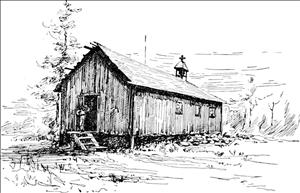In 1892, Native Americans organize the Indian Shaker Church. Unrelated to the American Shakers (the United Society of Believers), the movement emerges at a time when tribal members are turning away from traditional practices and beliefs, but are still excluded from Euro-American society and culture off the reservations. In early years, believers were harassed by some missionary groups and Indian agents.
The movement that became the Indian Shaker Church began in 1882 when Sahewamish (Squaxin) Tribe member and Mason County logger John Slocum (d. 1882) experienced a revelation from God who informed him that Native Americans could achieve salvation by turning away from drinking, gambling, smoking, and the shamans or traditional doctors who still exerted influence. According to Slocum, God would give followers a medicine stronger than the shamans. Slocum's wife Mary is said to have experienced the "Shake" when she received the promised medicine from God. This came at a time of great disillusionment among Puget Sound tribes, which in the course of one generation had been dispossessed of the region and relegated to tiny reservations, poverty, and discrimination. "The Shakers draw from traditional Indian belief to say that everything is enveloped by God, is influenced by God, and influences God" (Giovannetti).
Although believers follow the Gospel of Jesus Christ, some do not believe in the Bible. They believe that the experience of the Gospel is written in the subconscious. Shaker ritual includes the creation of sacred space and provides communication from this to the spirit world. Ritual also protects believers from ego inflation, or being overcome by evil. "When Shakers enter a church, they symbolically turn away from the world of the profane, or unconscious, to the world of the Holy" (Giovannetti).
The first Shaker Church was built at Shaker Point opposite the Squaxin Island Indian Reservation in South Puget Sound. From 1883 to 1932, the movement spread throughout the Northwest. In 1910, the members incorporated under the laws of the state of Washington. In 1927, a schism over the use of the Bible in services resulted in two separate churches, the Indian Shaker Church and the Indian Full Gospel Church. By 1996, the movement encompassed approximately 21 congregations and 3,000 members in Washington, Oregon, Northern California, and British Columbia.

